Berlin's five main gaslight types
1. The Model lamp
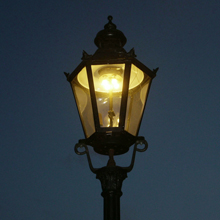
Model lamp, photo: Bertold Kujath
number: 1,200
since: 1892
number of mantles: 4
lamppost shape: cluster pier
places of interest: Chamissoplatz, Kreuzberg
Details
In 1892/93, the Model Lamp was the standard lamp model of the Berlin Municipal Gasworks. The lamp's form was based on earlier designs by Karl Friedrich Schinkel, which gave rise to the nickname 'Schinkel Lantern' (Schinkel-Laterne).
The Model Lamp is commonly mounted on an ornamental post in the shape of a clustered pier. Occasionally, the lamps are mounted on wall brackets, for example, in the historic centre of the Old Town Spandau. Moreover, Model Lamps exist as chandeliers with two, three or five arms.
The Model Lamp's original design foresaw two incandescent gas mantles. However, from the 1950s onwards, most Model Lamps were replaced with U7 top-piece lights (see below). The remaining Model Lamps were converted to today's design with four flames.
Today, approx. 1,200 of Berlin's Model Lamps remain. The majority of the lamps can be found in the areas surrounding the Charlottenburger Schloss and the Chamissoplatz (Kreuzberg), in the residential area Heerstraße, and in Spandau's old town (here the lanterns are mounted on wall brackets). A smaller number of Model Lamps is scattered across individual streets, city squares and a village green in Hermsdorf, Lübars, Tegel, Wilmersdorf, Marienfelde and Lichtenrade.
An original five-armed chandelier from 1903 still stands on Charlottenburger Schlossstraße and at Karl-August-Platz. Examples can be found on Wilmersdorfer Straße, at Stuttgarter Platz and at the Gaslaternen-Freilichtmuseum, Berlin's open air gas lantern museum. A design variation of the five-armed chandelier stands at Hohenzollernplatz (Nikolassee) and at the Dahlem Dorf underground station. Finally, Alt-Tegel is one of the areas home to three- and two-armed Model Lamp chandeliers.
2. Top-piece lamps
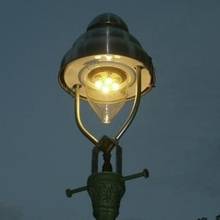
Top-piece lamp, photo: Bertold Kujath
number: 30,800
since: the 1920s
number of mantles: 4, 6 in special cases
lamppost form: clustered pier, steel pole
places of interest: Leonhardtstraße , Charlottenburg
Details
Top-piece lamps are probably Berlin's best-known gas street lamps.
Top-piece lamps first appeared in Berlin in the 1920s. The top-piece lamps we see today, the 'BAMAG U7' model, were installed since the 1950s. The U7 lamp has been used to replace Model Lamps and earlier versions of top-piece lamps. Moreover, if existing gas street lamps were deemed to stand too far apart, the U7 was used to fill the gap. Today, over 30,000 top-piece lamps exist in Berlin making them the most widespread form of gas street lighting in the city.
In contrast to the Model Lamps, U7 lamps have always contained four incandescent mantles. Only rare specimens contain six. Similar to the Model Lamps, the majority of top-piece lamps are mounted on cast iron posts in the shapes of clustered piers. A smaller number of top-piece lamps are mounted on steel poles. As opposed to the cast iron posts, the surface of these poles is smooth. Additionally, various models of steel poles exist.
Some of the clustered pier posts are already over 100 years old. One can identify these posts by the manufacturer's mark I.C.G.A. (Imperial Continental Gas Association), which is located at the foot of the pier. Despite their age, these cast iron posts are as good as new. Their special construction prevents any corrosion on their insides.
In the eastern part of Berlin, one can find top-piece lamps of the model 'Graetzin'. This model was made in the former GDR. The lamp has a black Bakelite top shaped like a cone. Several lamps stand in Köpenick, Biesdorf, Kaulsdorf and Mahlsdorf. In the Western part of Berlin, the U7 lamps illuminate large parts of the city. From the northern to the southern districts the lamps stand almost end-to-end. Typically, the lamps can be found in residential streets. As an exception, Leonhardtstraße (Charlottenburg) features double rows of top-piece lamps on the pavements.
3. Suspended lamps
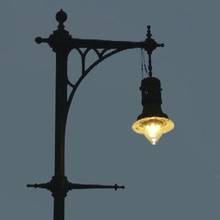
Suspended lamp, photo: Bertold Kujath
number: 3,600
since: 1905
number of mantles: 4 or 9
lamppost forms: 'Gallows', 'Bishop's Crosier'
places of interest: Schlossstraße, Charlottenburg
Details
Suspended lamps first illuminated Berlin in the early 1900s. Between the 1920s and the 1950s, these lamps experienced their widest use.
The majority of suspended lamps we see in Berlin today are 'BAMAG A11' types.
This model is typically fitted with 4 or 9 incandescent mantles. The A11 has been in use in West Berlin since the 1940s. The majority of suspended lamp posts, however, originate from an earlier time period. Therefore, these posts show various, at times very ornate, designs. Particularly striking are the so called 'Great Gallows' (Große Galgen) and the 'Great Bishop's Crosier' (Große Bischofsstab).
Suspended lamps are most often found along current or former high streets. The light point of suspended lamps sits quite high above the traffic lane. This design made them ideal for lighting busy streets. From the 1950s onwards, however, modern in-line lamps (described below) started to replace suspended gas lamps. Today, approximately three and a half thousand suspended gas lamps still exist in Berlin. Most of these lamps stand in Kreuzberg.
Similar to the top-piece model, the former GDR also produced a cone-shaped 'Graetzin' suspended lamp. Several of these lamps still survive in Köpenick, Biesdorf, Mahlsdorf and Kaulsdorf.
Gas street lighting projects involving complementary gas lamp types can be found in Charlottenburg (Sophie-Charlotten-Straße) and in Kreuzberg (Reichenberger Straße). On these streets, suspended lamps with nine mantles illuminate the traffic lanes. Additionally, the pavement is lit by Schinkel lanterns or U7 top-piece lamps respectively. Both of these pilot projects have been realised in cooperation with Gaslicht-Kultur (back then Gaslicht-Initiative-Berlin). In both instances, the projects prevented the electrification of the street lighting.
4. In-line lamps
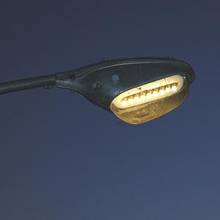
In-line lamp, photo: Bertold Kujath
Number: (2012) 8,200; presently 950
since: 1952
number of mantles: 4, 6 or 9
lamppost forms: largely 'whip posts'
places of interest: Dernburgstraße, Lietzensee, Charlottenburg
Details
The 'in-line lamp' (Reihenleuchte) constituted the last big innovation in gas street lighting technology. The lamps were named for the novel layout of their incandescent bodies: all were aligned in a row.
In the early 1950s, the stiff competition between gas and electric street lighting led to the development of the in-line lamp model. At that time electric strip lights had only recently become available. The in-line lamp was designed to be their equal. To ensure maximum light emission, the in-line lamp's incandescent bodies were staggered like the steps of a stairway. Ultimately, the in-line lamp model succeeded in keeping Berlin's gas street lighting viable.
In-line lamps are truly Berlin born-and-bred. Their developer, the engineer Wilhelm Hilterhaus, was the long-time departmental head of gas street lighting at the Berlin gas works (GASAG). Both the in-line lamp and its whip shaped post (Peitschenmast) were designed and tested on the Torgauer Straße factory premises.
In the post war period, in-line lamps replaced many suspended lamps on high streets and larger side streets. Additionally, in-line lamps were installed on the majority of newly constructed streets. The most common model we see in Berlin today is the 'BAMAG U13H'. This model may either be fitted with four, six or nine incandescent bodies. Typically, the U13H is mounted on whip posts. A smaller number of lamps are mounted on cantilever posts, which have been fashioned from former suspended lamp posts.
Many of Berlin's still existing in-line lamps stand in the historic garden city of Frohnau. Additionally, several lamps stand in the south of Berlin. Moreover, the World Heritage Site 'Weiße Stadt' is home to 31 in-line lamps. One of the most beautiful sights can be found on Bismarckallee (Grunewald). This avenue is lined by grand nine mantle in-line lamps. It's worthwhile to take a ride down Bismarckallee sometime in the early evening hours, especially on the top level of a M19 Bus.
In-line lamps together with Berlin's other gas street lamps create characteristic lighting ensembles. In some city areas, gas lamps still light the particular streets and squares they were originally intended for. Seen in combination, the different historical lamp forms complement each other in lighting whole city areas. More specifically, U7 top-piece lamps light residential streets, Model Lamps brighten the more prestigious squares and in-line lamps illuminate the traffic heavy collecting roads. Figuratively speaking, in-line lamps can be seen as the backbone of Berlin's gas street lighting.
In 2012, 8,200 in-line lamps still stood in Berlin. Two years later, their number has been almost halved. Today, only 4,500 in-line lamps remain. The Berlin Senate plans to demolish almost all in-line lamps in the next few years. A first historical gas street light type will then have disappeared from Berlin's cityscape.
5. Cylinder lamps
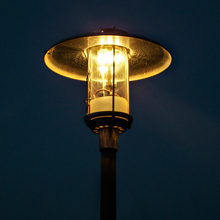
Cylinder lamp, photo: Bertold Kujath
number: 80
since: 2000
number of mantles: 4
lamppost forms: modern steel pole
places of interest: Jürgen-Schramm-Straße , Gatow
Details:
To date, the 'cylinder lamp' constitutes the latest innovation in gas street light technology. The cylinder lamp is also called 'modern top-piece lamp' (moderne Aufsatzleuchte). The Berlin public has dubbed it 'Paella Dish' (Paella-Schüssel).
Among other innovations in gaslight technology, the engineer Michael Kraft developed the cylinder lamp. Like Wilhelm Hilterhaus, Michael Kraft worked for the Berlin gas works (GASAG). He was the last departmental head responsible for gas street lighting.
In 2000, cylinder lamps were installed in the modern residential areas of Gatow and Buchholz.
The cylinder lamp consists of a basic electric light fixture which is fitted with state-of-the-art gaslight technology. The lamp has four incandescent mantles.
In Berlin, the innovation of gaslight technology and the development of increasingly economic gas lamp models have ceased to be of interest. Therefore, the cylinder lamp just plays a minor role in today's cityscape. Only 80 lights were ever installed.
Among other places, one can see cylinder lamps in Gatow's Jürgen-Schramm-Straße and its side streets.
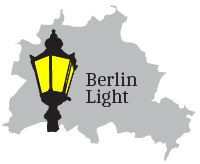



 Hängeleuchte
Hängeleuchte Reihenleuchte
Reihenleuchte